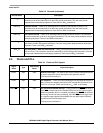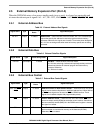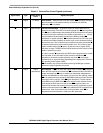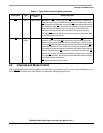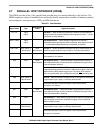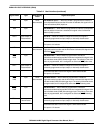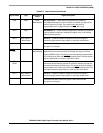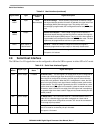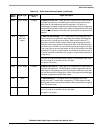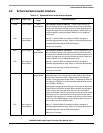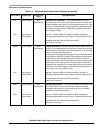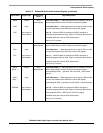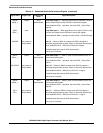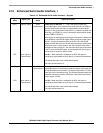
Serial Host Interface
DSP56366 24-Bit Digital Signal Processor User Manual, Rev. 4
2-12 Freescale Semiconductor
2.8 Serial Host Interface
The SHI has five I/O signals that can be configured to allow the SHI to operate in either SPI or I
2
C mode.
HACK/
HACK
Input GPIO
disconnected
Host Acknowledge — When HDI08 is programmed to interface a single
host request host bus and the HI function is selected, this signal is the host
acknowledge (HACK) Schmitt-trigger input. The polarity of the host
acknowledge is programmable, but is configured as active-low (HACK
) after
reset.
HRRQ/
HRRQ
Output Receive Host Request — When HDI08 is programmed to interface a
double host request host bus and the HI function is selected, this signal is
the receive host request (HRRQ) output. The polarity of the host request is
programmable, but is configured as active-low (HRRQ
) after reset. The host
request may be programmed as a driven or open-drain output.
PB15 Input, output, or
disconnected
Port B 15 — When the HDI08 is configured as GPIO, this signal is
individually programmed as input, output, or internally disconnected.
The default state after reset for this signal is GPIO disconnected.
This input is 5 V tolerant.
Table 2-10 Serial Host Interface Signals
Signal
Name
Signal Type
State during
Reset
Signal Description
SCK Input or output Tri-stated SPI Serial Clock — The SCK signal is an output when the SPI is configured as
a master and a Schmitt-trigger input when the SPI is configured as a slave.
When the SPI is configured as a master, the SCK signal is derived from the
internal SHI clock generator. When the SPI is configured as a slave, the SCK
signal is an input, and the clock signal from the external master synchronizes
the data transfer. The SCK signal is ignored by the SPI if it is defined as a slave
and the slave select (SS
) signal is not asserted. In both the master and slave
SPI devices, data is shifted on one edge of the SCK signal and is sampled on
the opposite edge where data is stable. Edge polarity is determined by the SPI
transfer protocol.
SCL Input or output I
2
C Serial Clock — SCL carries the clock for I
2
C bus transactions in the I
2
C
mode. SCL is a Schmitt-trigger input when configured as a slave and an
open-drain output when configured as a master. SCL should be connected to
V
CC
through a pull-up resistor.
This signal is tri-stated during hardware, software, and individual reset. Thus,
there is no need for an external pull-up in this state.
This input is 5 V tolerant.
Table 2-9 Host Interface (continued)
Signal Name Type
State during
Reset
Signal Description



